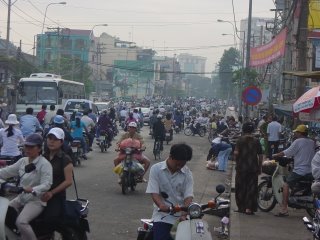A striking number of the videos are simply footage of streets or intersections in countries like India, China or Vietnam. Most of them show traffic that at first glance looks completely and utterly CRAZY, often with a mind-boggling diversity of road users doing anything and everything you could imagine.
And the amazing thing is that it seems to work. For some good examples look here or here.
One traffic clip (this one of an Indian intersection) provoked hot discussion at sustran-discuss in April. Some saw it as horrifying, while others suggested it was actually working very well. No consensus emerged I am afraid (see here and several responses). By the way, the Indian video looks to me like it may have been deliberately sped up a little to improve the slapstick effect!
Here is one of the approving sustran-discuss comments:
As it happens, I shot a similar video last summer in Urumqi, except there's also a pedestrian crossing going through it which is freely used by the cars doing u-turns. I started to video it to show people how bad the traffic and driving was. After 10 minutes of filming I realised that it all worked rather well, and felt suitably humbled about my prejudices.Let me assume for today that the chaotic looking situations in these videos are actually rather safe, with few serious accidents (although probably quite a few minor ones). This is a big assumption (and I don't have the evidence to make it) but it does not seem unreasonable.
The roads in these videos all seem somewhat 'naked' - along the lines of the 'shared space' approach to road and intersection design. Maybe they are inadvertently naked and not by careful design as shared space advocates might want. But these streets or intersections are working (maybe even working well!?) without all the traffic engineering paraphernalia or signs and traffic lights, etc. Or maybe the signs and lights are just being ignored.
Does this threaten to turn our quest for order and traffic discipline on its head? Maybe streets with vulnerable road users actually NEED a certain amount of chaos to work safely!? Maybe they need to have all those crazy turning movements, mixed vehicles, pedestrians meandering and bicycles sailing through in order to keep everyone awake and alert to the unpredictable? Maybe, as David Engwicht puts it, safe streets need more intrigue and uncertainty not more predictability.
Someone else wasn't so sure, however:
It is a trade-off of efficiency and safety! Similar driving behaviorsIndeed, some of the videos DO show examples of chaotic Chinese urban traffic going HORRIBLY wrong (WARNING: not for the squeamish - some of these crashes are a tad upsetting).
and situation in most of Chinese cities, resulting an "official record"
of 100,000 more fatalities and 520,000 more injuries annually!!
This made me wonder. A casual look suggests that the key difference might be speed. The accident scenes in the video from China almost all show situations in which the traffic is light and the speeds high, even though in most cases nothing much else is different about these crash intersections compared with other 'chaotic' intersections. This is more a question than a conclusion, of course, based on this little video-based 'investigation'!
But running with this idea for a minute anyway, maybe the horrendous traffic accident statistics that we read about low-income countries (high rates of accident per vehicle, not per capita) are not happening at the really 'crazy' times at all and are not a result of the obvious disregard for rules - at least not when it is at its most obvious?
 Maybe these same chaotic places only become dangerous when the traffic is lighter, when there is not enough chaos, and the motor vehicles tend to pick up speed? A hypothesis that would be worth testing more carefully I think.
Maybe these same chaotic places only become dangerous when the traffic is lighter, when there is not enough chaos, and the motor vehicles tend to pick up speed? A hypothesis that would be worth testing more carefully I think.A bunch of other questions arise. I wonder if there are any simple design features for such places that could prevent speeds, and hence danger, from increasing at times when traffic is light?
The naked streets toolbox apparently can work such magic ... with designs that make it feel like a pedestrian or playing child or bicycle might leap out in front of you at any moment, even if there are none around. Could we find low cost ways to do this that would suit Indian or Vietnamese cities? Or maybe I don't know enough about shared spaces as done in Europe. Could it be that Dutch naked streets also get dangerous when there are too few people using them?I must find out.
On the traffic efficiency side there are other questions, which I will save for another day.
